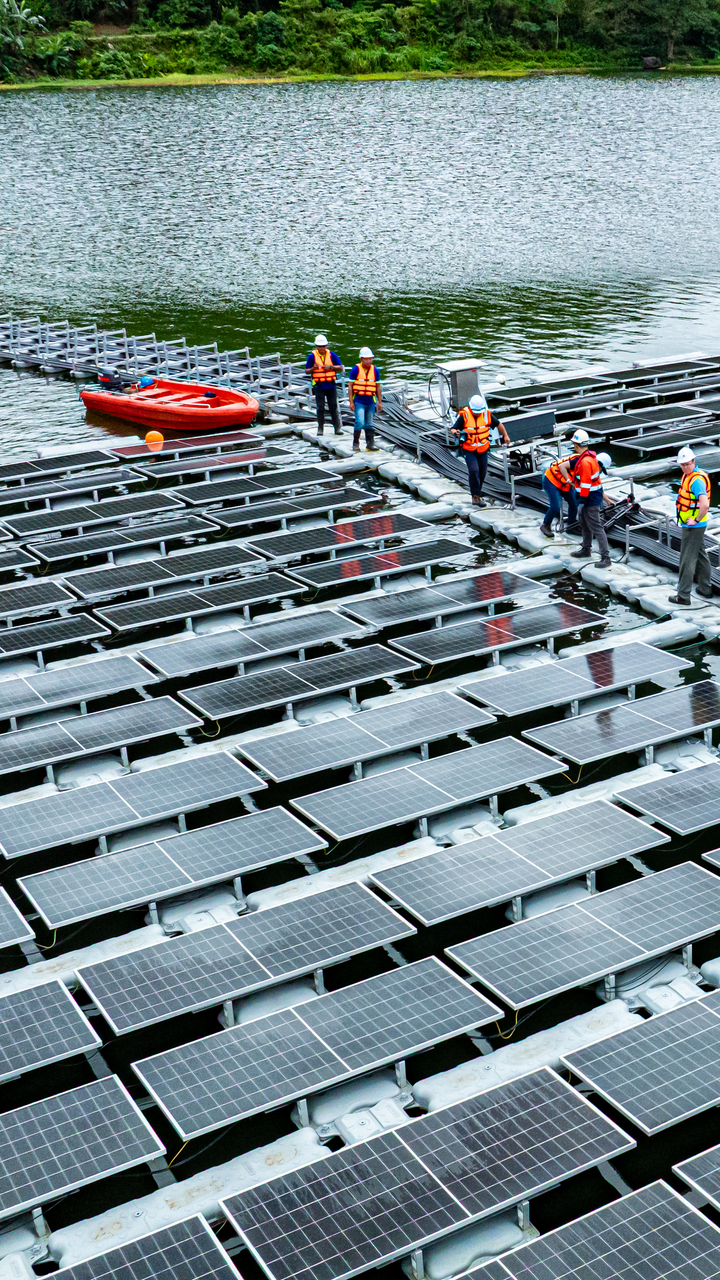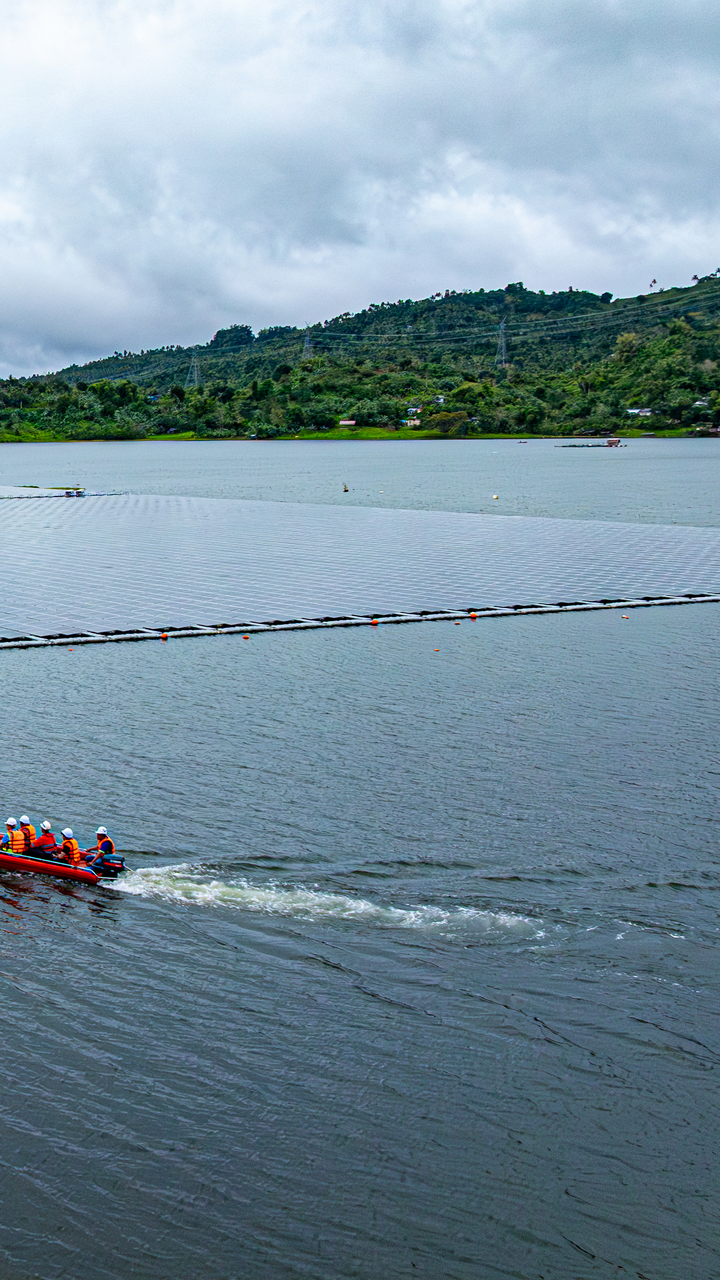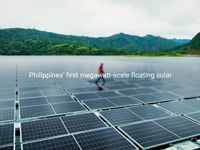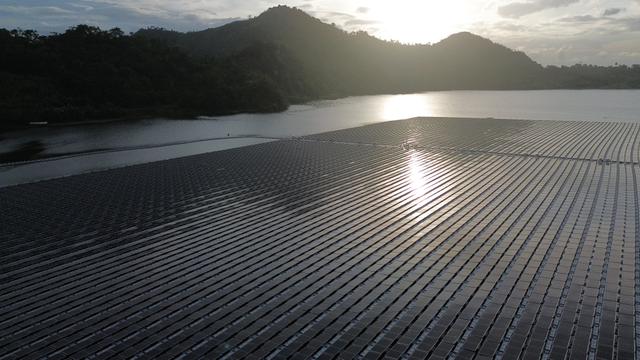The Carmen Copper solar field encompasses about 3 hectares, or roughly 7 acres.


A long, winding and at times bumpy drive on gravel takes you from Cebu City’s vibrant streets up to Carmen Copper Corp.’s mine in the mountainous heart of the Philippines’ Cebu Province. The Malubog Reservoir comes into focus, along with the remarkable sight atop it: a pioneering renewable energy array, designed and built by Black & Veatch.
As the country’s first megawatt-scale floating photovoltaic (PV) plant, the project reinforces Carmen Copper’s commitment to lower its carbon footprint and speaks volumes about the mining company’s rapport with and commitment to the local community consulted and informed each step of the way.
After being trained, locals helped build it, transforming some 3 hectares — roughly 7 acres — of the reservoir into a first-of-a-kind facility worth beholding, both for its breadth and for the innovation unseen beneath the surface.
Built to contribute to Carmen Copper’s power demand – the 4.996-megawatt (MW) facility is made up of 8,540 PV modules and floaters. The project is designed to scale up to 50 MWs, with the potential to fully power Carmen Copper’s operations with renewable energy.
The Carmen Copper solar field encompasses about 3 hectares, or roughly 7 acres.

The project – executed by Black & Veatch, a global leader in energy solutions — includes a prefabricated substation and a six-kilometer overhead distribution line linked to Carmen Copper’s existing 34.5-kilovolt (kV) substation.
Using solar panels fixed at a constant tilt angle, the power from the sun will prove valuable during peak energy hours, helping the company’s quest to meet environmental compliance standards and achieve its own goals to be more energy responsible.
Taken together, the floating photovoltaic project — “floatovoltaics,” for short — embodies Carmen Copper’s advances in pursuing a greener, cleaner operational future. It’s a striking example of a sustainable solution to land constraints, a leadership benchmark illustrating the ability of Black & Veatch to marshal its deep know-how to build a rooftop-like solar plant on water when the rugged terrain wouldn’t allow such an array on land.
From concept to completion, the project took roughly 15 months and for now will cover at least one-tenth of Carmen Copper’s power needs, meeting government mandates involving renewable energy for a mining company. There’s capacity for more and perhaps battery storage.
Welcome to the collaborative convergence of engineering, environmental science and renewable energy innovation.

It’s a striking example of a sustainable solution to land constraints, a leadership benchmark illustrating the ability of Black & Veatch to marshal its deep know-how to build a rooftop-like solar plant on water.
Carmen Copper’s foray into floating solar reflects the Philippines’ ongoing growth in renewable energy capacity and the country’s ambitions to actively develop floating solar power, given its many large inland lakes suitable for such development.
It's in that context that Carmen Copper in September 2022 called on Black & Veatch to develop a power system impact report, then a front-end engineering and design (FEED) analysis to better understand what it takes to move the project into the engineering, procurement and construction (EPC) stage. The process involved navigating the natural questions: How much will it cost to build and operate? How will that be paid for? Will it be truly reliable?
Ultimately, the companies’ cultures — shared emphasis on being stewards of the environment, meeting compliance and regulatory requirements, and being socially conscious — meshed. Black & Veatch was hired as the topline EPC contractor in December 2023 and went to work the following spring.
Preassembled onshore, buoyant platform “floaters” crafted of recycled plastic supported the solar arrays. Twenty-eight panels were fixed to each section, towed in four to six segments at a time by rubberized tugboats across the reservoir and positioned before incrementally being bracketed together. The array then was tied to mooring lines linked to the submerged concrete anchor blocks and positioned using a sonar global positioning system (GPS), all under Black & Veatch supervision for quality assurance.
The advantages of floatovoltaics are abundant. Water surfaces don’t cost as much as land. The layout is more compact, and water cools the corrosion-resistant panels, giving them greater efficiency than their on-land counterparts. Floating solar is especially useful in areas with limited land availability and even can mitigate water evaporation through the shading the panel flotilla provides. And water levels can be controlled by the reservoir’s dam.
The project, completed on time and within budget, was a showcase of safety, achieved by more than 250,000 man-hours without lost time injury.

Along the way, Black & Veatch and Carmen Copper collaborated on ensuring safety during the rigorous construction, ultimately achieving more than 250,000 man-hours without lost time due to injury. Training was provided to the subcontractors and the local laborers, who had different levels of understanding of preferred safety protocols. With that, workers went home unharmed to their families each day.
As the region migrates to renewables, what transpired on the serene reservoir — on time and within budget — offers yet another testament to how the right planning, collaboration, creativity and a bold vision of a transition to a greener energy ecosystem can deliver innovative, reliable power.
